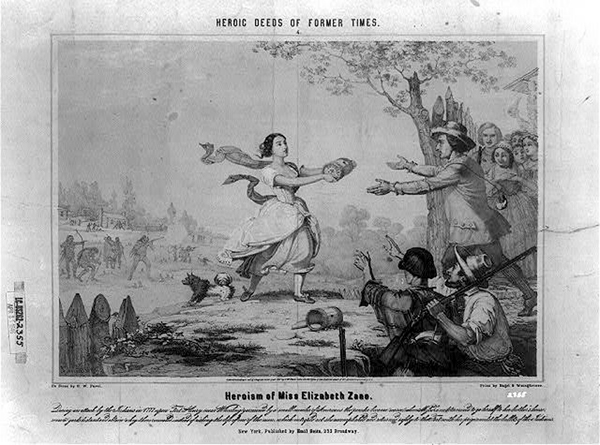

Hear them roar ~ Some tough-as-nails women you should know
I attended grade school in the 1950s. In the fifth grade, we learned about all the famous frontiersmen: Daniel Boone, Lewis Wetzel, Simon Kenton and William Wells. All men – and never a woman – that was the 1950s for you.
One day, a fellow student asked the teacher a question that I had not previously pondered. The student, called Martha by the teacher and Marti by us kids, asked the teacher, “Was there any girl frontiersmen?”
Miss Crabtree (not her real name) immediately addressed Marti’s lack of proper grammar in posing her question, as teachers are wont to do.
She told Marti that a girl could not possibly be a frontiersman, meaning, of course, that the female gender disagreed with the word frontiersman, implying a male.
However, Marti, mistaking the meaning of the teacher’s response, took outright umbrage at the assertion that a girl could not be a frontiersman.
I know for a fact that Marti put fear in the heart of at least one boy in our class and several in other classes, including the sixth grade. And not just the shy and retiring types either. Marti willingly went head to head with the bullies until they backed down and they never challenged her again. Which was, of course, her intention.
So, clearly, the relationship between intimidation and one’s sex was not a relevant concern for Marti. This quality of her personality would likely serve her well as she became a woman in a man’s world.
Once Miss Crabtree understood the intent and context of Marti’s question, she became noticeably flummoxed. She temporarily put off Marti by calling an emergency recess.
The last time we received such an unexpected reprieve from our studies was when Homer Potts released a humongous black snake in the classroom next door.
But, off to the playground we ran, screaming and shouting, caring little about whether women ever wore buckskin or carried a long rifle.
When we returned from recess, Miss Crabtree, having done due diligence to Marti’s inquiry during the break, held up a book to the class. The book was titled “Betty Zane” by Zane Grey. *
Marti and the rest of our class were about to learn that there were women as courageous and capable as any mountain man.
Elizabeth (Betty) Zane is a true heroine of what would eventually become the great state of West Virginia, then a mountain wilderness.
Miss Crabtree told how 16-year old Betty saved her family and neighbors from certain death at the hands of the British and Native Americans during the siege of Fort Henry on September 11, 1782.
From all accounts – and there were many on both sides – a scout for the Americans arrived at Fort Henry, now downtown Wheeling, West Virginia. He advised the settlement inhabitants that British-backed forces were on their way to attack.
And indeed, 300 Seneca, Delaware, Wyandot and Shawnee warriors, including Simon Girty, joined forces with 50 British Butler’s Rangers on the outskirts of the settlement.
Within the stockaded Fort Henry were some 40 American soldiers and their families. They held off the British and native warriors the first day without casualties.
On day two of the siege, they were running out of gunpowder, and the desperation was palpable.
Young Betty Zane remembered a store of gunpowder secreted in one of the cabins about 60 yards outside the fort.
This daring young woman reasoned that the enemy would be less inclined to shoot a woman if she made a go for the gunpowder. She knew precisely where the powder was hidden, and she was a physically strong woman.
So, at high noon, Betty opened the fort’s main gate and quite literally walked to the cabin. Note that I said walked, as opposed to run.
Everyone inside and outside the fort, friend and foe, was astonished at her fearlessness in the face of such danger. Perhaps her striking features temporarily stunned the soldiers. Betty was known for her raven hair and dark eyes.
On her return trip with the gunpowder, the enemy forces had gathered their wits about them. And, they soon took aim and fired at Betty as she ran up the hill and back into the fort without so much as a scratch. (Makes me wonder if they fired into the air; I would have.)
Betty managed this act of courage and stamina without sleeping for the previous 40 hours because she was busy melting lead and making bullets.
The store of gunpowder Betty retrieved was responsible for the American victory – often said to be the final battle of the Revolutionary War.
It should be said that of the 47 people involved in defending Fort Henry that warm fall day, there were no fewer than 12 women on hand.
Miss Crabtree wasn’t the only one moved by Betty’s story. All the girls in the class and most of the boys were absolutely spellbound as they listened to the account. I’d like to think that at least some of the students gained an understanding from this story that bravery is not the sole province of males.
Now, I don’t know what happened to Marti beyond her grade school years. But, a safe bet could be made that she entered some occupation dominated by men. Perhaps, a power lineman or an ironworker walking six-inch beams 40 stories above the ground.
In my mind’s eye, I can also see her in a uniform slapping the cuffs on some hardened criminal. Or, she may have been a successful prosecutor – she certainly didn’t suffer bullies.
And, I have no doubt that she earned the respect of the men who worked with her.
In the next couple of episodes of For Your Consideration, we will meet some women from history who took on jobs that many men would back away from in abject fear.
We’ll learn about women like Stagecoach Mary Fields; she carried mail into hostile territory where being killed was just an occupational hazard.
We will also pay our respect to some formidable women right here in Pocahontas County. So please stay tuned.
Author’s Note: A few thoughts on Wheeling, West Virginia, the location of Fort Henry:
When I was a resident of Ohio, I was not a Buckeye fan, as I thought Mountaineers was the more charming of the two words.
And everyone outside Ohio knows that a buckeye is defined as a useless nut. This allegation may have some validity, considering the fact that the squirrel is the only animal that will eat a buckeye.
Wheeling, West Virginia, is a town that must be passed through to get from Bridgeport, Ohio, to West Alexandria, Pennsylvania, a mere 14 miles.
Wheeling is, after all, situated on that tiny sliver of land called the Northern Panhandle, which appears on a map as a finger poking up through its neighbors to the north – Ohio and Pennsylvania.
This was intentional on the part of West Virginia so as to have as much access as possible to the Ohio River. After leaving Pennsylvania, the river enters West Virginia at the very tip-top of the panhandle near East Liverpool, Ohio.
Many years ago, I patrolled the Ohio River from East Liverpool to Gallipolis, Ohio, for the Ohio Department of Natural Resources. I always enjoyed passing between Wheeling Island and the city of Wheeling.
You might say I became somewhat fond of the old city on the Ohio River.
Once I became a long-established resident of West Virginia, I began regarding Wheeling as an island of civility. An island surrounded by rabid Buckeye fans on one side and marauding Keystoners on the other.
With this constant threat of a barbarian invasion, perhaps it is now time to rebuild Fort Henry in Wheeling.
If a prospective governor were to run on this issue, I could just imagine his supporters shouting, “Build the fort. Build the fort.”
Hey, let’s do it for Betty Zane.
Until next week,
Ken Springer
Ken1949bongo@gmail.com
*Zane Grey, a great-grandnephew of Betty Zane, has authored more than 90 books upon which 112 films are based. He mostly wrote westerns, and “Riders of the Purple Sage” was his best-selling book. “Betty Zane” was a work of historical fiction based upon Betty’s diaries.



